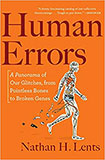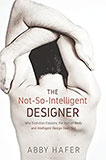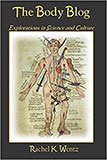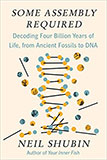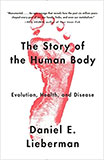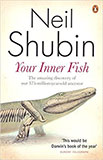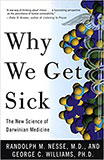
UnInTeLLigEnT
dEsIgN
THE ARGUMENT FROM POOR DESIGN
Also known as the Dysteleological Argument, is an argument against the existence of an omnibenevolent creator god. The reasoning follows that if there existed a deity that possessed unlimited intelligence, love, talent, knowledge, power, resources and time, it would not create creatures with obvious design flaws and suboptimal features.
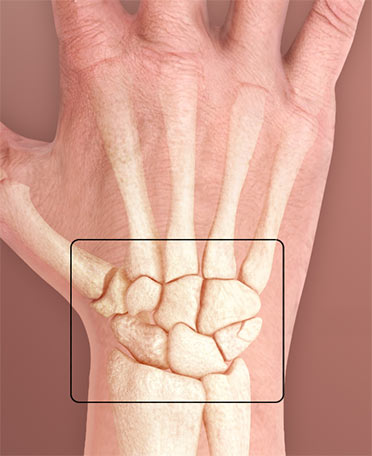
From our lethal plumbing to painful crowded teeth, a stump of a tail, redundant cluttered bones, and no redundancy where reinforcement is most needed, the inability to make vitamins and nutrients that other animals easily make for themselves, nerves that take bizarre paths and lymph nodes that do more harm than good, the human body is a collection of compromises.
The research below is just a short outline of some of the worst flaws and compromises the human body possesses. They have been chosen from the many because they are major structural flaws. There are many more, such as immune system and genetic cancer causing flaws that have been omitted. Omitted to avoid the creationist argument of “Well, things were very different before 'The Fall.'”
In order to use that defense on the below listed design issues, the creationist would have to maintain that there was a literal Adam & Eve and their bodies were designed completely different from regular human bodies. That their eyes, bones, muscles, joints, nerves, openings, digestive system and organs were structurally and positionally different. In other words: they weren't human.
BIRTH, THE LEADING CAUSE OF DEATH
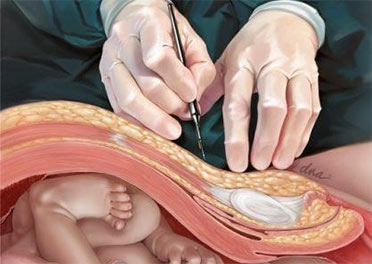
It is no exaggeration to say that for most of our species' existence, being born was the leading cause of death. And for women, giving birth was the next biggest cause. So many women died giving birth in ancient times that there was a Roman law stating that when a pregnant woman died, her stomach was to be opened in an attempt to rescue the fetus. In ancient times, caesareans were performed by the patient herself, her husband, barbers, midwives, surgeons or even tribal natives. A variety of instruments were used, ranging from razors to axes. As recent as the 17th and 18th centuries, after the uterine incision and the removal of the child, there was no technique yet to suture the uterine walls, relying instead upon contractions and retraction to control hemorrhage. Most women died from hemorrhage or infection. The maternal mortality following the procedure was reported to be between 52.5% and 100%. In colonial times, women would write out their will during pregnancy in anticipation of death. All this, yet in most other mammals, such complications and mothers dying during childbirth is virtually nonexistent.
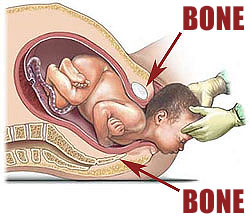
Birth in other mammals is not even a dramatic affair. Cows seem to barely even notice when they give birth. Gorilla mothers even continue to eat or care for other young during delivery. However, in humans, every 11 seconds a pregnant woman or newborn dies somewhere around the world. The size of the human head is just way too large for the human birth canal. Today, cesarean delivery occurs in 1 in 3 women in the United States, and up to 4 in 5 women in some regions of the world. Even in the 21st century, counties that do not have access to advanced medical procedures still suffer from an infant mortality rate of 10-11%. Meaning even today, 1 out of every 10 deliveries results in the child's death. Prior to 1955, several countries' infant mortality rate was above 20%. In the centuries before hygienic practices and antiseptic operating rooms, a cesarean almost always killed the mother and only occasionally saved the child. All due to shortcomings in our species' gestational design.
All this, despite human infants which are born way earlier and less mature than other mammals. In humans, fetal gestation is cut short and human babies are born premature and helpless. This is not the case for most other mammals. Cows, giraffes and horses for instance virtually hit the ground running. Dolphins and whales are born underwater and without hesitation swim independently to the surface to take their first breath. Even with zero medical intervention, childbirth is much safer for primate mothers in the wild. Mother's dying in childbirth is unheard of in chimpanzees, bonobos, gorillas and all of our other primate cousins.
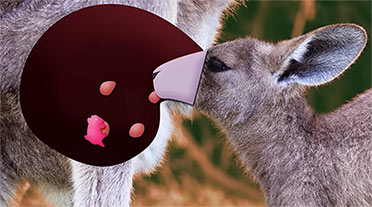
We see a better design in marsupials like koalas and kangaroos. Kangaroos for instance, are bipedal like humans but they easily give birth to extremely small young with no difficulty and then nurture them in a pouch for about six months. A pouch that even contains nursing nipples! Humans actually now simulate this kangaroo-style design with baby bottles and baby carriers sometimes called "wraparounds" or "wraparound slings."
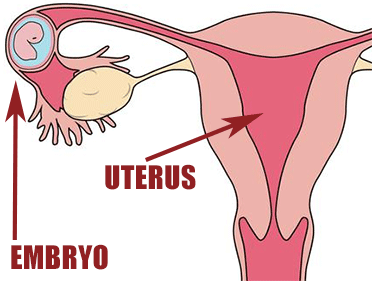
Other birth related maladies such as lithipediums and abdominal pregnancies which also kill women are entirely the result of poor design. Any reasonable plumber would have attached the fallopian tube to the ovary. Thereby preventing fatal mishaps like these. Even the most unimaginative engineer could have given egg cells some sort of means of propulsion or put cilia on the walls of the fallopian tube to gently guide the fertilized egg cell into the uterus. Either of those ideas would eliminate tubal pregnancies and both are possible with design structures that already exist elsewhere in the body. Considering 1-2% of all conceptions result in tubal implantation. Which is likely an underestimate, since 10-33% of tubal implantations resolve themselves through the death and flushing of the embryo before it has implanted too deeply.
LETHAL PLUMBING
Sinuses that drain upward?
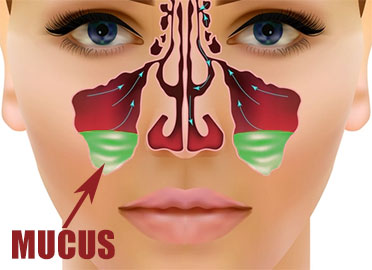 The human sinus drainage system is so poorly designed that one of the most important drainage pipes is tiny and installed at the top of the largest pair of mucus collection cavities, the maxillary sinuses. Putting the drainage collection point high within the sinuses is not a good idea, due to this little thing called gravity. With this design, the largest and lowest cavities must drain upward. There are cilia to help propel the mucus upward against gravity, but it would be much easier to have the drainage below the sinus cavity. What plumber would put a drainpipe anywhere but the bottom of a chamber? To make matters worse, as mucus becomes thicker from dust or bacteria, things go from bad to worse. If only humans had gravity to help with the problem as other animals do. Instead, our cilia must work against gravity along with the thickened mucus and they simply can't keep up. This inevitably leads to the infamous bacterial sinus infection. In some people, mucus drainage is so poor that only nasal surgery can remedy their constant nasal infections.
The human sinus drainage system is so poorly designed that one of the most important drainage pipes is tiny and installed at the top of the largest pair of mucus collection cavities, the maxillary sinuses. Putting the drainage collection point high within the sinuses is not a good idea, due to this little thing called gravity. With this design, the largest and lowest cavities must drain upward. There are cilia to help propel the mucus upward against gravity, but it would be much easier to have the drainage below the sinus cavity. What plumber would put a drainpipe anywhere but the bottom of a chamber? To make matters worse, as mucus becomes thicker from dust or bacteria, things go from bad to worse. If only humans had gravity to help with the problem as other animals do. Instead, our cilia must work against gravity along with the thickened mucus and they simply can't keep up. This inevitably leads to the infamous bacterial sinus infection. In some people, mucus drainage is so poor that only nasal surgery can remedy their constant nasal infections.
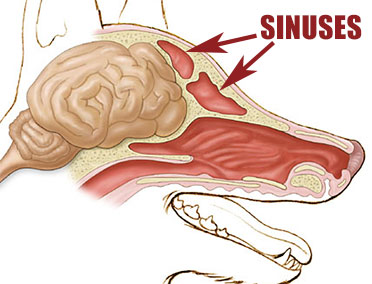
Ever wonder why dogs, cats and other animals don't get head colds ever or nearly as often as humans? Most dogs can live their entire lives without ever having a sinus infection or head cold. Evolution explains this poor design. As our brains got larger, our snouts regressed due to less reliance on smell and more on eyesight. Our nasal cavities moved around as they got smushed into the more flat and compact face that we see today.
Air and Fuel Intakes Combined?
The human throat is perhaps one of the most inept designs of the entire human anatomy. Imagine if every time you put fuel into your car there was a chance that it could get into the air intake and make your engine choke, perhaps causing it to fail permanently if the spillage were large enough. No car designer has ever been inept enough to pipe the fuel intake and air intake entrances together.
Humans are the only mammal that cannot breathe and swallow at the same time, and we are the only species that can choke on its own food. The reason? The lowering of the voice box in our throats (during infancy) enables us to create the enormous range of sounds used in producing language; but this lowering of the voice box comes at a big cost in adulthood.
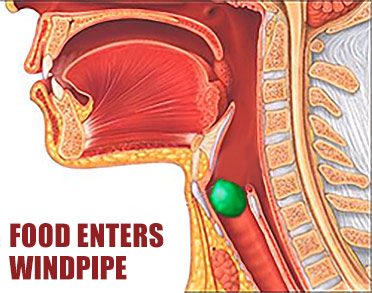
At least one child dies from choking on food every five days in the United States alone. Choking is a leading cause of injury and death among children, especially those younger than 4 years of age. Having air and food passages meet and mix is not only a terrible design idea, but is too often fatal. When a large enough piece of food gets inhaled into the trachea (windpipe) it will asphyxiate the person, who then has only minutes to live if no outside intervention is available. Over five thousand otherwise healthy Americans died from choking last year, mostly on food. It's inconceivable that anyone would design a human that has to endure a certain amount of risk every single time food or liquid is ingested.
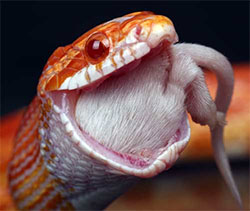
A better designed system would keep the tubes for food and air separate to avoid unnecessary fatalities. Afterall, it's that way in other animals such as birds, reptiles, whales and dolphins. Their digestive systems are completely separate from their respiratory systems. It's impossible for them to ever have their lungs obstructed by their food and die. Snakes for example, can swallow a gigantic meal over a span of hours while easily breathing the entire time, since their nostrils convey air directly to their lungs rather than merging with their throat. Conversely, each time a human swallows, they have to stop breathing momentarily. Having two separate anatomical structures for digestion and respiration would make much more sense in terms of hygiene, immune defense and the general maintenance of these very different systems. Also, using the same tube for inhaling and exhaling is referred to as "tidal breathing." A horribly inefficient technique due to the great deal of stale air that remains in the lungs each time fresh air is brought in. They then mix, diluting the fresh oxygen content of the inhale. This limits oxygen delivery causing humans to breath deeper, especially during moments of peak demand.
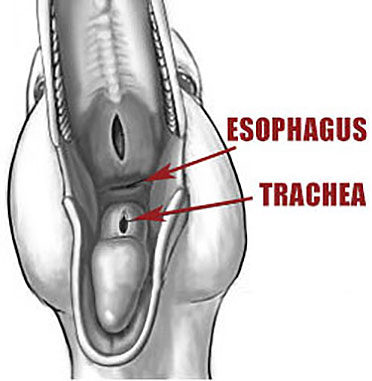
The superior way to breath is seen in birds. In many birds, the airway splits into two lanes of "traffic" before it reaches the lungs. Inbound air heads directly to the lungs, never mixing with stale air. Stale air is collected into an out-spout, joining with the trachea (windpipe) only high in the throat. One-way flow of air into the lungs ensures that the air is passing through the lung unidirectionally and always fresh and full of oxygen. This more efficient design allows birds to take far shallower breaths than humans do to deliver the same amount of oxygen into their bloodstream.
Lastly, an annoying but much less fatal "feature" of this incompetent plumbing is the fact the human nostorals are connected as well. Anyone that has ever had their nostrils filled with the burning sensation from vomit or carbonated beverage knows this all too well. Imagine if a plumber piped your home in a way so that each time you flush your toilet, there was a chance that the kitchen sink would turn into a sewer fountain.
Additional reading: How Birds Breath with Their Butts, How Birds Breathe Better
TESTES
In the human male, the testes develop initially within the abdomen. Later during gestation, they migrate through the abdominal wall into the scrotum. This causes two weak points in the abdominal wall where hernias can, and too often form. Prior to modern surgical techniques, complications from hernias, such as intestinal blockage and gangrene usually resulted in death. Today even with modren medical technology, survival is not guarnteed. Well-thought-out, intelligently designed creations all have their most vulnerable parts well protected. A car engine and transmission are both mounted inside a reinforced metal frame and body. A computer motherboard and CPU chip is mounted with multiple screws inside a metal or thick plastic box. Mobile phones CPUs and RAM are now even housed inside shock and waterproof casing. This list goes on. The human testicles which are vital for reproduction, literally dangle freely outside the male body in order to cool them.
Having normal body temperature be too hot for sperm production is poor design. All of the other abdominal organs are safely tucked up inside the body out of harm's way and function at our average body temperature of 37°C. Most other animals do not have this problem. Their sperm making equipment is protected safely inside them. For instance, you would need to preform a dissection on a male frog to find it's testicles. As Neel Ingman puts it in his book titled: Not Very Intelligent Design, "What genius would design a body part that didn't function properly at body temperature? I guess we're lucky our kidneys and lungs aren't hanging out below our armpits."
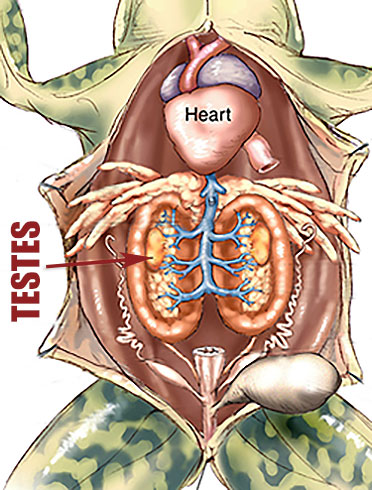
Sloths, elephants, anteaters and birds are just some of the many animals with internal testicles which have obviously functioned just fine for millions of years.
HARDWIRED FOR OBESITY

Starvation at one point was an ominous threat to all humans. Now, obesity is replacing starvation as a scourge in many parts of the world. The main problem is that we are hardwired for fuel that is high in fat and high in sugar for it's caloric value and energy. Our cravings are almost always for high fat, high sugar foods. Conversely, we do not crave most of the foods that are lower in calories and supply us with essential vitamins and minerals such as fruits, fish and leafy greens. Does this make any sense in today's world? When was the last time you had an intense craving for asparagus?

It was once thought that our increasing sedentary lifestyles were to blame for this malady. However, it was soon discovered that even people who make their living through physical work are in no way immune from obesity. The opposite is true in fact. As both obesity and physical labor directly correlate with lower income and education. Also, children that spend more time engaging in physical play are more likely to develop obesity as adults. People who are active athletes throughout their childhood and even young adulthood are more likely to be obese in their 30s, 40s and 50s. Particularly when their physical activity wanes. This is due to the over-consumption of calorie-rich foods. Scientists have noted that intense exercise leads to intense hunger. Which often leads to poor diet choices. And our now easy access to calories only makes matters worse.
This was just not the case for most of human existence. Before the last two centuries, most humans simply did not have easy access to diets rich in meat and sugars. It was the industrial revolution that began to bring plentiful food access to the masses. Overeating was a fine strategy when it wasn't possible to do very often. Studies have shown that our bodies contain a metabolic design that causes us to gain weight easily and lose weight with difficulty. Anyone who has struggled with their weight will tell you that weeks of dieting and exercise often result in negligible weight loss, yet a weekend calorie binge can put on some pounds quickly.
So why are we drawn to high calorie foods, regardless of their vitamin deficiency? Our metabolic design evolved in a very different world than we live in today. The human ability to gain weight easily and lose weight with great difficulty made sense on the African savanna when we were chasing dinner for miles and went days or even weeks without eating. However, it's not a great benefit now at a time when food is so easily accessible for many.
BAD TO THE BONE
Pain in Back
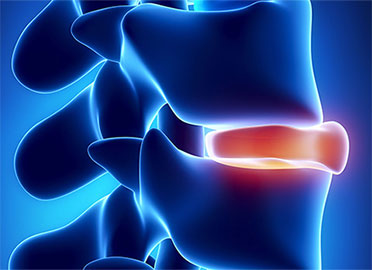 In humans, the spinal discs are in an arrangement that is optimal for knuckle draggers, not upright walkers. This leaves them prone to being pushed out of place. They are designed to resist gravity by pulling the vertebral discs toward the chest, as if humans were on all fours. With our upright posture however, gravity often pulls them backward or downward away from the chest. Over time, this uneven pressure creates spinal disc herniations known as "slipped discs." Slipped discs are virtually unheard of in other species.
In humans, the spinal discs are in an arrangement that is optimal for knuckle draggers, not upright walkers. This leaves them prone to being pushed out of place. They are designed to resist gravity by pulling the vertebral discs toward the chest, as if humans were on all fours. With our upright posture however, gravity often pulls them backward or downward away from the chest. Over time, this uneven pressure creates spinal disc herniations known as "slipped discs." Slipped discs are virtually unheard of in other species.
The Boneyard
The human wrist is way more complicated than it needs to be to accomplish what it does. And the unnecessarily redundant bones actually limit its motion so that it cannot reach its full potential. There are eight different bones piled in the wrist, like a pile of rocks. Which is about how useful they are. We do have examples of superbly designed joints like the hip and shoulder. However, no sane engineer would design a joint with so many moving parts. It clutters up the space and restricts the range of motion. If the wrist were rationally designed, it would allow the hand a full range of motion. The flexibility of the wrist joint is restricted by it's many bones, not facilitated by them.
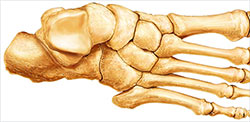
The human ankle has a very similar design flaw. It has the same clutter of bones that we find in the wrist. There are 7 bones, most of them pointless. Many of these bones do not move relative to one another and would function much better as a single fused structure, including their many ligaments replaced by solid bone. Thus stronger, with many of the current points of potential strain eliminated altogether. There is a reason that twisted and sprained ankles are so common. The skeletal design of the ankle is a hodgepodge of parts that can do nothing except malfunction.
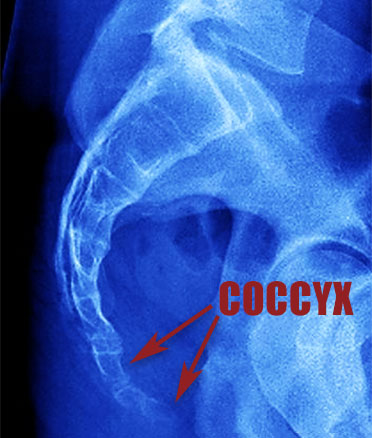
The tailbone (coccyx) is another pointless feature of human anatomy. It is made up of three to five fused bones (depending on the person) that have no function. It doesn't house or protect anything. The spinal cord which vertebrae are there to protect, ends much higher than where the tailbone begins. The tailbone is vestigial. A remnant from our ancestors who had tails.
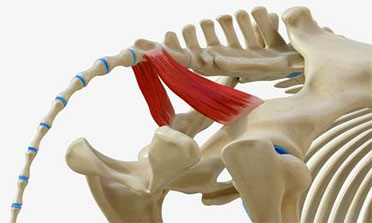
Attached to the tailbone is even a tiny remnant of a muscle. The dorsal sacral coccygeal muscle, that could flex the tailbone if it wasn't now fused in humans. It's the same muscle that dogs, cats, horses, etc. use to wag their tails. A pointless muscle for this pointless cluster of now fused bones. While it can now be used to bear some weight for a person while sitting, people who have had to have it surgically removed, like other vestigial anatomy (appendix, wisdom teeth, ear muscles, etc.) face no long-term consequence.
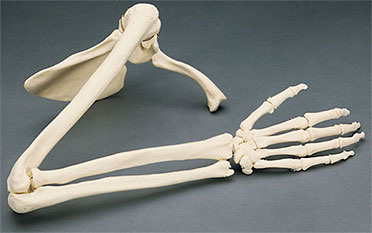
Lastly, we also find paired bones connected to single bones in our forearms and lower legs. The upper arm has one bone but the lower arm has two. The thigh has one bone but the shin has two. The two bones in the lower arm do allow for a twisting motion, but that's not the case in the lower leg. You cannot twist your leg below the knee without breaking something. Even in the forearm, having two parallel bones is not the only way to make a joint that can twist. In fact, having two bones ensures that the twisting cannot exceed 180 degrees since the bones unavoidably knock into each other when you twist them. For comparison, the shoulders and hips do the task of twisting even better than the elbow. And they do it without the two bone arrangement. No robot arm will ever be designed to imitate our nonsensical bone structure.
SUPPORT NEEDED
The ACL
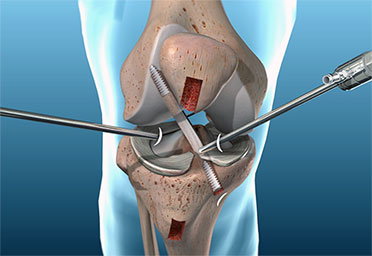 While we see problematic redundancy in our bones, we find vulnerable points where redundancy is desperately needed, yet absent. The anterior cruciate ligament (ACL) is one of the key ligaments that help stabilize your knee joint. The tearing of this ligament is one of the most frequent sports injuries, even in the most fit athletes in the world. But can also occur during regular daily activities.
While we see problematic redundancy in our bones, we find vulnerable points where redundancy is desperately needed, yet absent. The anterior cruciate ligament (ACL) is one of the key ligaments that help stabilize your knee joint. The tearing of this ligament is one of the most frequent sports injuries, even in the most fit athletes in the world. But can also occur during regular daily activities.
The ACL under the kneecap connects the thigh bone to the shin bone. It does most of the work holding the upper and lower leg together. It is vulnerable to tear in humans because our upright bipedal posture forces it to endure much more strain than it is "designed" to. In quadrupeds (four legged animals), the strain of running and jumping is distributed among four limbs, and the limb muscles absorb most of it, not the ligaments.
To make matters worse, it is not possible to isolate the ACL and strengthen it with exercise. And repeated strain doesn't make it stronger. It actually weakens it. If that weren't bad enough, when the ACL is torn, the only way possible to repair it is graft surgery (tissue transfer from another part of your body or a donor) with a long recovery and rehabilitation time. This is because ligaments unlike muscles are fed by very few blood vessels and very few cells that do the work of healing and rebuilding tissue. Prior to the 20th century, ACL tears were a permanently painful walking disability.
The (not so) Great Achilles
The achilles tendon attaches the calf muscle to the heel of the foot. Unlike the ACL, the achilles tendon can be strengthened by exercise. However, by taking on most of the strain of the entire ankle joint by itself, injuries to the achilles tendon are also at the top of the most frequent sports injuries. And there is no built-in redundancy for this tendon to offer support as some other joints have. To add to the problem, the achilles is exposed prominently on the back of the leg unprotected. If the tendon is injured, even walking is impossible. The poorness of this design can be summed up in the observation that the function of the entire joint rests on the actions of its most vulnerable part. A modern mechanical engineer would never design a joint with such an obvious liability.
VESTIGES FROM DAYS PAST
Like the above-mentioned tailbone that is now fused together and features a useless muscle, the human body contains other vestigial parts that no longer serve their original purpose, and worse yet, some can actually kill us.
A Woody Diet
One of the most nefarious human vestiges is a pencil-sized cylinder of tissue called the appendix. And like wisdom teeth, some humans are no longer born with an appendix. It is a blind sac (no exit) pouch-like structure that serves as a fermenting vessel for bacteria that break down woody plants and bark into usable sugars. In primates whose diets include fewer woody plants, the secum and appendix are smaller. And in humans who can’t digest cellulose, the appendix is nearly gone altogether.

Appendectomies are the most common emergency operation that general surgeons perform — at a rate of more than a quarter of a million a year. Not only is there no detriment to removing the appendix, removing it appears to reduce incidents of ulcerative colitis. As paleontologist Alfred Romer once remarked, “It’s major importance would appear to be financial support of the surgical profession.”
It’s narrowness allows it to easily clog, leading to a lethal infection and inflammation known as appendicitis. Most cases of appendicitis will cause the appendix to rupture and kill the person if it is not surgically removed in time. When the appendix ruptures, a large number of harmful bacteria flood the abdominal cavity causing mass infection, including infecting the peritoneum, which is the lining of the abdominal cavity. This causes the peritoneum to become inflamed (peritonitis), which can quickly lead to sepsis (full-body inflammation) causing shock and wide-spread organ failure. About one in fifteen humans will develop appendicitis in their lifetime. In 2013, it resulted in 72,000 deaths globally, down from 88,000 in 1990. Before the late nineteenth century, death from appendicitis was routine. In other words, throughout most of human history, we’ve lived with a ticking time bomb in our gut.
Ear Muscles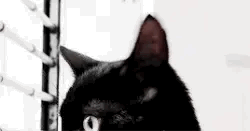 If you can wiggle your ears you are demonstrating evolution. Humans have three muscles under their scalp that attach to their ears. In most people they are completely useless. However, some people can use them to wiggle their ears. These are the same muscles used by other animals like cats and horses to move their ears around helping them localize sounds. In those species, moving the ears helps them detect predators’ location, locate their young and hunt. This is especially useful for nocturnal animals that cannot rely on sight alone for survival. Not only did humans retain three of the muscles involved in ear movement, studies have shown that these muscles still respond to sound. They just don't respond strongly enough to make our ears move anymore.
If you can wiggle your ears you are demonstrating evolution. Humans have three muscles under their scalp that attach to their ears. In most people they are completely useless. However, some people can use them to wiggle their ears. These are the same muscles used by other animals like cats and horses to move their ears around helping them localize sounds. In those species, moving the ears helps them detect predators’ location, locate their young and hunt. This is especially useful for nocturnal animals that cannot rely on sight alone for survival. Not only did humans retain three of the muscles involved in ear movement, studies have shown that these muscles still respond to sound. They just don't respond strongly enough to make our ears move anymore.
Goosebumps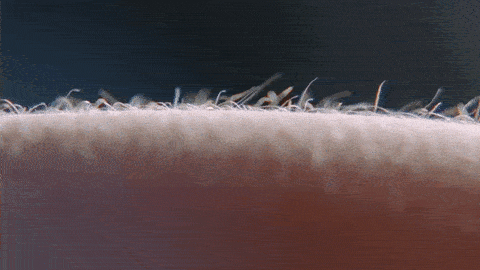 The Arrector pili are the tiny muscles that attach to the base of each human body hair. When they contract, the hair stand up giving us “goosebumps.” This serves no useful function in humans. In other mammals they raise the fur to increase the amount of space for insulation to help them stay warm when it’s cold and also cause the animal to look larger when it's making or receiving threats. Our vestigial goosebumps are produced by the same exact stimuli as other animals: a rush of adrenaline.
The Arrector pili are the tiny muscles that attach to the base of each human body hair. When they contract, the hair stand up giving us “goosebumps.” This serves no useful function in humans. In other mammals they raise the fur to increase the amount of space for insulation to help them stay warm when it’s cold and also cause the animal to look larger when it's making or receiving threats. Our vestigial goosebumps are produced by the same exact stimuli as other animals: a rush of adrenaline.
Unwise Teeth
Only 200 years ago, dental abscesses were a leading cause of human death. The human jaw has become smaller via evolution and the wisdom teeth and the third set of molars that erupt behind the two sets of molars, typically in a person’s late teens or early twenties no longer have space to grow. As a result, these teeth often are misaligned or impacted (stuck below the gum line) and require removal to prevent potential dental health problems, such as overcrowding, decay, gum disease, infection, and damage to neighboring teeth.

By the 1950s, the advent of antibiotics dramatically reduced infection-related deaths. Early human ancestors likely wore out their teeth by early adulthood and needed a third set of molars for continued function. Before agriculturally-based foods were produced, humans ate a diet of hard-to-chew foods like roots and raw meat. Though there is evidence of “chew sticks” being used anciently to clean teeth, a lack of oral hygiene inevitably would have led to decayed and missing teeth. So an extra pair that emerged later in life would not have been a large problem.
Some people never develop wisdom teeth, others only have one or two, and many of us develop all four. However, most people just don’t have enough room for any number of these third molars, thus they commonly need to be removed. Additional reading: Genome News Network
Baby’s Grip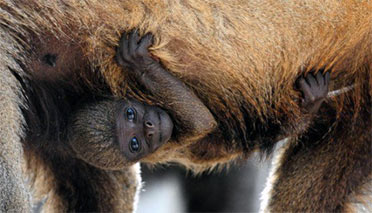 Known as the palmar grasp reflex, where infants up to about six months old have an incredible grasp on whatever you place in their hand. There is even a similar reflex for their feet. You can find videos and photos demonstrating this behavior. Babies only a month old can literally hang for minutes supporting their entire weight. Biologists have found that the reflex is significantly more frequent in infants of fur carrying primate species. They theorize that the grasping reflex evolved as it is essential to survival in species where the young are carried in the fur. In humans, if the palmar grasp reflex persists beyond 2 to 4 months, it can actually delay or affect functions like grasping a rattle, releasing objects from hand and also hand manipulation skills.
Known as the palmar grasp reflex, where infants up to about six months old have an incredible grasp on whatever you place in their hand. There is even a similar reflex for their feet. You can find videos and photos demonstrating this behavior. Babies only a month old can literally hang for minutes supporting their entire weight. Biologists have found that the reflex is significantly more frequent in infants of fur carrying primate species. They theorize that the grasping reflex evolved as it is essential to survival in species where the young are carried in the fur. In humans, if the palmar grasp reflex persists beyond 2 to 4 months, it can actually delay or affect functions like grasping a rattle, releasing objects from hand and also hand manipulation skills.
Optional Forearm Muscle?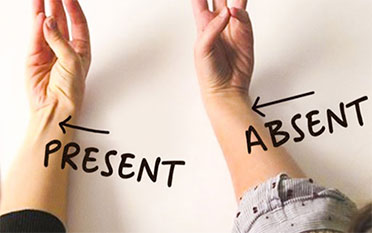 Currently, ten to fifteen percent of humans are born without the palmaris longus, in one or both of their forearms. It is a thin strip of muscle running between the wrist and the elbow. There seems to be no real reason for it being there. It's actually one of the first muscles that surgeons will take for use in reconstructive and cosmetic surgeries. Research has found that the presence of this muscle in our forearms does not give us any more discernible arm or grip strength than people born without the muscle. In fact, it's so inconsequential, surgeons routinely remove it and use it for reconstructive or plastic surgery procedures elsewhere on the body.
Currently, ten to fifteen percent of humans are born without the palmaris longus, in one or both of their forearms. It is a thin strip of muscle running between the wrist and the elbow. There seems to be no real reason for it being there. It's actually one of the first muscles that surgeons will take for use in reconstructive and cosmetic surgeries. Research has found that the presence of this muscle in our forearms does not give us any more discernible arm or grip strength than people born without the muscle. In fact, it's so inconsequential, surgeons routinely remove it and use it for reconstructive or plastic surgery procedures elsewhere on the body.
So why do we have such a useless piece of tissue? Scientists have found that, while palmaris longus is present in many species of mammals today, it's most developed in those that use their forearms to move around quickly and swing from trees - such as lemurs and monkeys.
INSUFFICIENT FUNDS
The human body requires an extremely varied diet to keep it healthy. Which was not always available to our ancestors. We are constantly reminded by our parents, teachers and doctors of all the various things we need to eat to stay healthy: “Eat your vegetables!” “Milk. It does a body good!” “Don’t forget the fruits!” “A balanced breakfast is important.” “Remember to get lots of fiber.” “Meat and nuts are important for protein!” “Be sure to get Omega 3 fatty acids!”
The vitamin supplement industry is a $36 billion dollar industry. Unlike other animals, it is impossible for humans to stay healthy by eating a narrow diet. And even people who eat varied diets can’t always absorb it’s vitamins and nutrients properly due to the combination in which they consume it.

Ironically, the calcium humans so desperately need but can’t produce in sufficient quantities themselves, often comes from milk produced by cows that eat virtually nothing but grass. Cows that live long and healthy lives producing healthy milk and iron rich meat. And what about our pets? Cats and dogs’ diets consist of not much more than meat and rice. No vegetables. No fruits. No leafy greens or legumes required. The reason is simple: They are better “designed” for eating. The human body fails to make many of the nutrients other animal bodies make.
Scurvy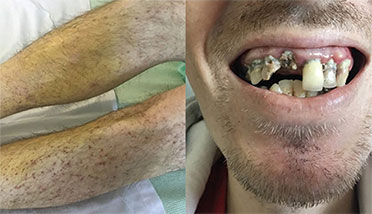 Caused by a vitamin C deficiency, sixteenth and seventeenth century European explorers discovered the hard way what happens when vitamin C rich foods are not available. By the eighteenth century, sailors learned to carry potatoes or limes on their voyages to prevent scurvy. In as little as one month’s time without sufficient vitamin C, weakness, tiredness, sore arms and legs, personality changes will occur. Eventually, death from infection will happen. Yet, nearly all other animals on the planet biosynthesize their own vitamin C in their livers, which gives them no need to get it from their diet.
Caused by a vitamin C deficiency, sixteenth and seventeenth century European explorers discovered the hard way what happens when vitamin C rich foods are not available. By the eighteenth century, sailors learned to carry potatoes or limes on their voyages to prevent scurvy. In as little as one month’s time without sufficient vitamin C, weakness, tiredness, sore arms and legs, personality changes will occur. Eventually, death from infection will happen. Yet, nearly all other animals on the planet biosynthesize their own vitamin C in their livers, which gives them no need to get it from their diet.
Rickets 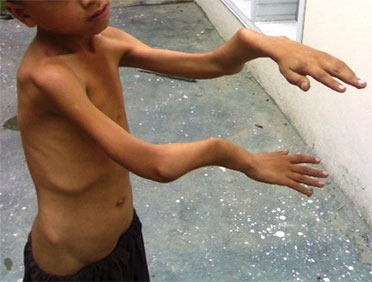 We know from studying the bones of early humans that Rickets and brittle bones were a constant problem. Our intestines are terrible at extracting calcium from our food. So bad in fact, that they attempt to extract it from our bones instead. And this problem only increases as you age. Without enough dietary vitamin D or sunlight, young humans can quickly develop Rickets, while older humans can develop Osteoporosis. They are both extremely painful and lead to weak bones that break easily and heal slowly. In some cases stunted growth and skeletal deformities result. Humans need calcium to prevent this and vitamin D to absorb the calcium. All the calcium intake in the world would do us no good without vitamin D to help our body absorb it. When human skin is exposed to sunlight, it makes vitamin D from cholesterol in the skin cells. Yes, the same sunlight that gives us wrinkles, age spots and cancer. And that our homes and clothes block.
We know from studying the bones of early humans that Rickets and brittle bones were a constant problem. Our intestines are terrible at extracting calcium from our food. So bad in fact, that they attempt to extract it from our bones instead. And this problem only increases as you age. Without enough dietary vitamin D or sunlight, young humans can quickly develop Rickets, while older humans can develop Osteoporosis. They are both extremely painful and lead to weak bones that break easily and heal slowly. In some cases stunted growth and skeletal deformities result. Humans need calcium to prevent this and vitamin D to absorb the calcium. All the calcium intake in the world would do us no good without vitamin D to help our body absorb it. When human skin is exposed to sunlight, it makes vitamin D from cholesterol in the skin cells. Yes, the same sunlight that gives us wrinkles, age spots and cancer. And that our homes and clothes block.
The majority of ancient skeletal remains show the telltale signs of calcium and vitamin D deficiency. So these are not new problems. They also appear more drastically and in younger people than we typically see today.
Pump the Iron
Despite the fact that there is plenty of iron in our bodies, our environment, our planet and our solar system, deficiencies in iron are one of the most common diet related ailments in humans. According to the CDC and WHO, iron deficiency is the single most common nutritional deficiency worldwide. That iron deficiency is pandemic in a world filled with iron is paradoxical to say the least. The WHO estimates that 50% of expecting mothers and 40% of preschool children are anemic due to iron deficiency. Current estimates are that two billion of the world’s seven billion people are at least mildly anemic. Nearly a million people die from the deficiency each year. Once again poor design is mostly to blame for this problem.

The human gastrointestinal tract is terrible at extracting iron from plant sources. In animal meat, iron is found in blood and muscle tissue. The iron in plants isn’t broken down by the human body much at all and end up being excreted. Contrast that with the fact that the majority of other animals on the planet are mostly or even completely vegetarian. Yet their intestines do just fine in processing iron.
In humans, we must maximize iron absorption by pairing iron rich foods with vitamin C. There are also molecules in other foods that directly interfere with human iron absorption. Most notably the iron in plants. Legumes, nuts and berries which we desperately need for their other benefits, contain polyphenols which reduce our ability to extract and absorb iron. Whole grains also interfere since they are high in phytic acid.
Calcium is yet another iron absorption interferer. It can reduce iron absorption by up to 60%. If you eat iron rich foods but pair them with calcium rich foods, you’ve negated your efforts. It’s not enough to eat the right foods to meet our exacting dietary needs. We must eat those foods in the correct combinations. Which is why in developed regions most people now opt for a multivitamin instead.
Anemia As noted above, nearly a million people die each year from anemia. Yet another example of poor design related to anemia is how humans desperately need vitamin B12, but we excrete it before our body can absorb it. B12 can only be absorbed by the small intestine in humans, yet it is large intestinal bacteria that produce it. In other words, the human gut is so poorly designed that we send all our vitamin B12 into the toilet! And in case you are wondering, you could technically eat your feces to get the B12 you need.
As noted above, nearly a million people die each year from anemia. Yet another example of poor design related to anemia is how humans desperately need vitamin B12, but we excrete it before our body can absorb it. B12 can only be absorbed by the small intestine in humans, yet it is large intestinal bacteria that produce it. In other words, the human gut is so poorly designed that we send all our vitamin B12 into the toilet! And in case you are wondering, you could technically eat your feces to get the B12 you need.
For thousands of other animals, the bacteria in their large intestine make B12 for them and they absorb it just fine. That is why thousands of animals are herbivores without the need to ever take vitamin supplements. Humans must eat foods rich in vitamin B12 or take many supplements.
Acid Test Protein deficiency is currently the single most life threatening dietary problem stemming directly from our inability to make nine of the 21 required amino acids for ourselves. The human inability to synthesize such basic things such as these amino acids exacerbates crises during a food shortage. During a famine, it’s not the lack of calories that is the ultimate cause of death. It’s the lack of proteins and the nine essential amino acids they provide.
Protein deficiency is currently the single most life threatening dietary problem stemming directly from our inability to make nine of the 21 required amino acids for ourselves. The human inability to synthesize such basic things such as these amino acids exacerbates crises during a food shortage. During a famine, it’s not the lack of calories that is the ultimate cause of death. It’s the lack of proteins and the nine essential amino acids they provide.
Plants make all amino acids for themselves. As a matter of fact, plants are more self-reliant than most animals because they can synthesize the energy source themselves from the sun. They use carbon and oxygen obtained from the air and hydrogen from water in the soil, forming carbon hydrate by means of photosynthesis and combining it with the nitrogen which is obtained from the soil, leading to synthesis of amino acids. In other words, plants make all their food internally. Animals are "designed" the exact opposite of self-sufficient. Animals must constantly kill and eat other living things to stay alive.
BAD DIRECTIONS
Recurrent Laryngeal Nerve
In mammals, the recurrent laryngeal nerve (RLN) does not go directly from the cranium to the larynx, the way any competent engineer would have arranged it. Instead, it extends down the neck to the chest, loops around a lung ligament and then runs back up the neck to the larynx. In a giraffe, that means a 20-foot length of nerve where 1 foot would have done. If this is evidence of design, it would seem to be of the unintelligent variety.
This is not only poor design but actually maladaptive. The extra length makes it more prone to injury. Humans have suffered significant injury when recieving a blow to the chest experiencing a paresis or palsy of the vocal cord, making it difficult to talk or swallow. Due to it's needless size and length, injuries have also occured during surgery on goiters, thyroids and the esophagus.
SLEEP

Our sleep requirement is probably the most obvious yet overlooked design flaw. We spend one-third of our entire lives lying unconscious. Imagine if your phone had to be off or unusable for eight hours every single day. Or your vehicle had to be turned off or charged for eight hours every single day. Would Apple sell a signle phone? Would Tesla sell a single vehicle?
To make matters worse, when sunlight hits our eyes each morning, it triggers cells in the brain that control levels of the hormone melatonin, which, in part, controls drowsiness. Light suppresses melatonin secretion, which wakes the body up. The more melatonin, the sleepier we are. These levels drop in the daytime and rise at night. Anyone who has ever worked third shift will tell you that the sleep struggle is real.
For more indepth reading on this subject:
